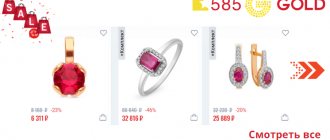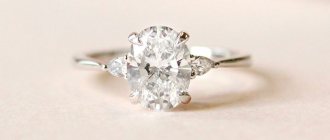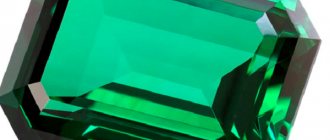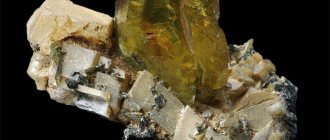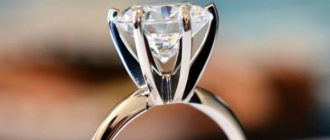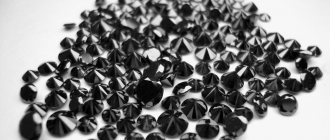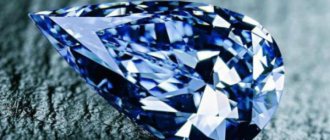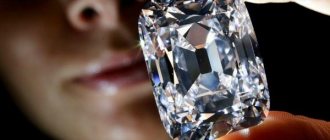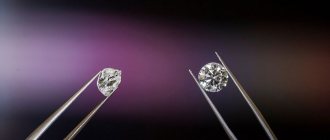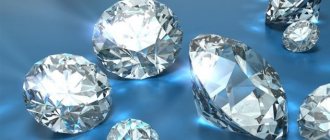Diamond is the most expensive and beautiful stone among minerals. He is a kind of model by which other gems are compared. However, none of them can replicate the unusual properties of a diamond.
What makes a diamond so beautiful? A parameter such as light refraction is responsible for the radiance of the stone: the higher the dispersion, the more beautiful the colors play.
Dispersion is the property of a stone to refract wavelengths of radiation at different angles, similar to a phenomenon such as a rainbow. An important factor is the hardness of the stone. Harder stones can be cut, which allows them to fully reveal their qualities.
White sapphire
In mineralogy, only the blue variety of the mineral is called sapphire; all the others, with the exception of ruby, are called corundum. White sapphire is a colorless, pure form of aluminum oxide and does not contain the oxides of other metals that color corundums in various shades.
The white variety of sapphire is used as a diamond imitation, or rather, a reasonable alternative to an expensive diamond. This very diamond-like stone is second only to diamond in hardness - 9 on the Mohs scale. The stone is almost impossible to damage. Unless, of course, you deliberately scratch it with industrial diamond or corundum.
Heat, gas and pressure
Let's delve a little deeper into the technical process itself, and then find out how to get a diamond at home. Let’s master, so to speak, the profession of jewelry technologists in order to understand how complex and painstaking work it is.
Today, there are two methods for producing diamond in a laboratory.
- Diamond powder is placed in a special capsule, which dissolves under pressure and high temperatures. Then the crystallization process occurs, which takes up to several months. The result is diamonds with cubic facets, different from real ones not only in shape, but also in the growth process itself.
- The second method also involves the presence of a chamber filled with gas. When exposed to energy flows, gas molecules in a vacuum are destroyed, and carbon atoms settle inside the capsule in the form of plates. In a large enough chamber, dozens of diamonds can be grown in a few weeks. They will be flaky, with rough black edges. Sometimes stones with this method are obtained with a brown tint, but all impurities are well cleaned during the heat treatment process. Then the craftsmen begin cutting.
White Topaz
White topaz, a natural semi-precious stone, aluminum silicate, with a hardness of 8 on the Mohs scale, is considered relatively weak by jewelers. It has a strong glass luster with a slight pearlescent tint. A well-cut stone looks like a real diamond. In jewelry, only a specialist can distinguish them.
Transparent sapphire and topaz are not imitations; rather, they should be called analogues of diamonds.
Where are synthetic diamonds in demand?
Often artificial stone causes a negative attitude. Still, this is a fake, not a real diamond, and supposedly such specimens are much worse than the originals. This is a bias for which there is no basis. An analogue of a diamond obtained in a laboratory has the same properties as the original. The scope of use of simulations is quite extensive:
- One of the advantages of a surrogate is durability. This makes it possible to use such diamonds in the field of high technology. The stones are used to create microcircuits and chips.
- The strength of the artificial analog allows the use of crystals for the production of drilling rigs, tools and equipment for cutting and grinding, and especially durable materials.
- Synthetic stones that have not been processed have found use in the medical field . They are used in medical equipment.
- Artificially created diamonds are a popular raw material in jewelry . Jewelry made from these stones is not inferior in brilliance and luxury to products made from natural gems.
Moissanite
Moissanite is a crystalline form of silicon carbide. Rarely found, it is usually found in or near meteorite craters. Almost all moissanite used in the jewelry industry is an artificially produced mineral.
Because of its hardness (9.5 on the Mohs scale), this imitation mineral is the closest thing to diamond in terms of durability. The stone looks similar to a diamond, but is very different from it in optical properties.
Moissanite outshines diamonds. I'm not kidding. The stone reflects light perfectly. The dispersion coefficient of moissanite is significantly higher than the dispersion coefficient of diamond. A beam of white light is decomposed into monochromatic rays of the entire spectrum of the rainbow. The stone shimmers like the lights of a neon advertisement, and this slightly vulgar shine immediately reveals the imitator. However, many people often refer to moissanite as a man-made diamond.
For lovers of glamor without the epic price tag of six months' salary, this is the perfect stone.
What is an artificial diamond
Creating synthetic diamonds is a complex process. It is difficult to reproduce in the laboratory the natural conditions under which a mineral is formed in nature. Perhaps this is why numerous attempts to obtain such a stone as an artificial diamond ended in failure.
The first mentions of experiments to invent a worthy replacement for a transparent crystal date back to the 19th century. In 1823, the scientist and engineer V. Karazin made the first successful attempts to create a gem similar to a diamond.
The official date of “birth” of the diamond analogue is considered to be 1905. The surrogate saw the light of day thanks to the efforts of the French scientist Henri Moissan. As a result of the experiments carried out by the researcher, a crystal of silicon carbide was obtained. Natural crystals are characterized by small sizes, so the fake was far from perfect.
However, the resulting substitute was found to be most similar in properties to natural diamond. The stone was named after the inventor - moissanite. Over time, scientists managed to synthesize larger specimens.
A substitute for natural diamonds obtained in laboratories these days, moissanite, is known as carborundum. Artificial crystals are made from natural silicon carbide, which is heated to 2400 degrees. In the production process of the substitute, iron is also used, which plays the role of a metal catalyst.
Diamonds are grown in a laboratory using carbon-containing substances.
This is, for example, graphite or coal. The classification of artificial crystals (HPHT diamonds and CVD diamonds) depends on the production method.
The size of stones grown in the laboratory does not exceed one carat. The production of large samples is not economically profitable, since such gems will be expensive. Nevertheless, successful attempts have been made in our country to grow crystals of larger sizes.
Cubic Zirconia
The zirconium dioxide crystal, first synthesized in the cubic system in 1970 for the needs of the optical industry, immediately attracted the attention of jewelers for its potential as a diamond simulator. In the Soviet Union it was called cubic zirconia, the technology was developed by scientists from the Physical Institute of the Academy of Sciences. In the West, the stone is called zirconium, zirconite and is designated by the abbreviation CZ.
Artificially grown from a melt in laboratory conditions in unlimited quantities and at an affordable price, the crystal immediately received the apt definition of “a diamond for the people.”
Today it is one of the most popular diamond substitutes. It can be found in products of famous jewelry brands and mass producers of luxury jewelry.
The stone has optical properties very close to the optical properties of diamonds. But not only these unique properties have contributed to the widespread use of cubic zirconium in jewelry. The stone is fantastically cheap: cubic zirconia weighing one carat costs about $20 on the world market. The growth technology is such that the crystal growth rate ranges from 8 to 10 mm/hour.
The main difference between cubic zirconia and diamond is its hardness, which is 8.5 on the Mohs scale. The stone is easily damaged and wears out quite quickly and loses its shine. In terms of specific gravity, cubic zirconium is much heavier than diamond.
Only an experienced connoisseur can visually determine which stone in jewelry, zirconium or diamond. Artificially grown crystals are always flawless, they do not have defects that are often found in natural gemstones. This, by the way, is the main express analysis used by jewelers. Comparing diamond and cubic zirconia does not require lengthy and complex analyzes. If the gemstone looks like a diamond but is flawless and perfect, it is undoubtedly cubic zirconia.
The leader in use for the manufacture of stylish jewelry with ultra-modern design is zirconium. A stone in jewelry can look both elegant and brutal, depending on the size and color of the crystal.
The technology for growing cubic zirconia crystals has been improved over the years to such an extent that the color of the crystals varies from transparent to black.
Spinel
A rare mineral, a mixture of aluminum and magnesium oxides. Transparent, uncolored varieties of spinel are sometimes used as diamond imitation. The stone, similar to a diamond, has a bright glass luster and good optical properties.
Like all substitutes, spinel is softer (about 8.0 on the Mohs scale) than real diamond.
Pomegranate
Colorless crystals are not found among natural garnets. But synthetic varieties of minerals can be created in laboratory conditions with any given color characteristics.
All colorless garnet crystals are artificial and are used in jewelry as an analogue of a diamond. It is mainly used in earrings, necklaces, pendants and pendants, since garnet is much softer than diamond - the hardness of synthetic garnet ranges from 7.5 to 8.5 on the Mohs scale. Its advantage as a diamond simulator is its luster: the colorless variety of the mineral has a diamond luster.
Materials used as analogues of diamonds in the jewelry industry
| Name and formula | Optical character | Refraction | Hardness | Dispersion | UV fluorescence | Specific gravity | Additional signs _ |
| Diamond (C) | Isotropic | 2,42 | 10 | 0,044 | Blue, green, yellow of varying intensity or absent | 3,52 | High thermal conductivity, abnormal birefringence, mineral inclusions |
| Cubic zirconia (ZrO2) | Isotropic | 2,18 | 8,5 | 0,060 | Faint yellow-orange or absent | 5,95 | Rarely - gas bubbles |
| Zircon (ZrSiO4) | Anisotropic | 1,78-2,01 | 6-7,5 | 0,038 | Moderate yellowish, orange, whitish | 3,95-4,80 | Mineral inclusions, high birefringence (split ribs) |
| Strontium titanate (fabulite) (SrTiO3) | Isotropic | 2,41 | 6 | 0,109 | Absent | 5,13 | Very strong dispersion, gas bubbles, sharp polish marks |
| Yttrium aluminum garnet (YAG) (Y3Al5O12) | Isotropic | 1,83 | 8,5 | 0,028 | Orange | 4,55 | Gas bubbles |
| Gallium gadolinium garnet (GGG) (Gd3Ga5O12) | Isotropic | 2,03 | 6,5 | 0,022 | Weak orange (SW) | 7,05 | Gas bubbles |
| Lithium niobate (linobate) (LiNbO3) | Anisotropic | 2,25 | 5,5 | 0,075 | Absent | 4,65 | Perfect cleavage, gas bubbles, high birefringence (split ribs) |
| Synthetic rutile (TiO2) | Anisotropic | 2,62-2,90 | 6-6,5 | 0,190 | Absent | 4,26 | Gas bubbles, high birefringence |
| Yttrium aluminate (YАlO3) | Isotropic | 1,97 | 8,5 | 0,033 | No data | 5,35 | Gas bubbles, no play of light |
| Glass | Isotropic | 1,44-1,90 | 5-6 | 0,009-0,098 | Miscellaneous | 2,3-4,5 | Rolled fins, gas bubbles, abnormal birefringence |
| Quartz (SiO2) | Anisotropic | 1,544-1,553 | 7 | 0,008 | Absent | 2,66 | Gas-liquid inclusions |
| Natural and synthetic sapphire (leucosapphire) (Al2O3) | Anisotropic | 1,76-1,77 | 8 | 0,011 | Moderate blue (CB) or absent | 4,00 | Very weak twinning, gas bubbles, inclusions |
| Synthetic spinel (MgAl2O4) | Isotropic | 1,73 | 8 | 0,010 | Various from inert to strong | 3,64 | Gas bubbles, polishing marks, abnormal birefringence (tatami pattern) |
| Synthetic scheelite (CaWO4) | Anisotropic | 1,92 | 4,5-5 | 0,015 | Pink, blue (KB) | 6,06-6,30 | Curved growth lines, gas bubbles |
| Topaz Al2SiO4 (F,OH) | Anisotropic | 1,61-1,62 | 8 | 0,014 | Weak to inert | 3,53 — 3,56 | Mineral and gas-liquid inclusions |
| Sphene (titanite) (CaTi[SiO4]O) | Anisotropic | 1,84-2,11 | 5-6 | 0,051 | Inert | 3,29-3,56 | High birefringence (split ribs), fragile |
| Zincite (ZnO) | Anisotropic | 2,02 | 4,5 | 0,060 | Green | 5,55 | Fragile |
| Moissanite (SiC) | Anisotropic | 2,69 | 9,5 | 0,090 | Inert or faint yellowish | 3,10-3,22 | High birefringence (split ribs) |
Rutile
Rutile is a natural mineral, pure titanium dioxide. Belongs to the category of semi-precious and ornamental stones. There is a developed industry for the production of a synthetic analogue of rutile. Colorless variations of the stone are not found in nature, but in laboratory conditions it is easy to grow a crystal without impurities. Sometimes used as a diamond simulator.
It is a fairly soft mineral, with a Mohs hardness of 6.0-6.5. Such hardness is considered insufficient for jewelry inserts in expensive metals, since even dust particles can leave scratches on them with strong friction. Rutile crystals are usually used in the production of costume jewelry for the mass consumer.
Astrological meaning
Since artificial diamonds are completely identical to natural ones, they can be worn by the same zodiac signs that correspond to a natural diamond. These are Fire stones, and they “love” mainly people of their element - Sagittarius, Leo and Aries. Among them, a diamond, including an artificial one, especially distinguishes Aries.
The wearing of diamond jewelry is contraindicated for the antipodes of Fire - the signs of the element of Water, especially Pisces.
| Zodiac sign | Compatibility |
| Aries | +++ |
| Taurus | + |
| Twins | + |
| Cancer | + |
| a lion | + |
| Virgo | + |
| Scales | +++ |
| Scorpion | + |
| Sagittarius | + |
| Capricorn | + |
| Aquarius | + |
| Fish | + |
(“+++” – fits perfectly, “+” – can be worn, “-” – is strictly contraindicated)
Magical properties of the stone
For a long time, it has been the custom to endow minerals with healing and magical powers. It is believed that precious stones can influence both individual parts of our body and the energy and destiny of a person as a whole. A carefully selected mineral can become a reliable talisman for its owner. Magicians often claim that stones have character and unique “emotions,” and in order for them to bring good luck, it is necessary to “make friends” with them.
But to what extent does all this relate to a sample of non-natural origin, which is cubic zirconia? The stone gained significance in magic, according to experts, due to its property of accumulating energy. Moreover, the one he has “increased” will be shared with his owner. That’s why experts advise not to buy this stone thoughtlessly, from resellers, because it is unknown who was the previous owner of the mineral and what “pedigree” the stone hides. Well, if you still purchased it, then it would be completely useful to clean the new thing with spring water or fire. They say that it is appropriate to give jewelry with cubic zirconia to newlyweds who will work together on a bright future.
Some magicians cautiously recommend using this stone as an amulet, since its unnatural nature seems to introduce an element of duality and insincerity: it is, after all, just a fake diamond!
In general, we can say that cubic zirconia is a stone for those who do not really rely on fate and miracles, but prefer to forge their happiness with their own hands.
Why was it created?
When experimenters synthesized this excellent artificial gem, they were not driven by aesthetic motives. The scientists' goal was to create high-temperature-resistant optical lenses and laser materials. However, jewelry masters instantly “fell in love” with the unique mineral, which amazes with the shimmer of light in its crystal-transparent facets no worse than a true diamond. The magnificent and cheap stone has made a fortune for more than one enterprising businessman. To this day, special delight is caused by jewelry in which the mysterious cubic zirconia shines in a frame of silver, platinum or gold - a stone whose significance has been confirmed by many years of successful position in the precious stones market. It even got to the point where scammers began to fake this stone, just like a real diamond.
Only a specialist will see the difference from the true “king of stones”. Cubic zirconia is heavier than a diamond, and when it is cut, the edges are more rounded. Sophisticated fashionistas will also notice that in a stream of bright light the diamond burns like a spark. Cubic zirconia shines somewhat more modestly.
